Blast链9700万美元争夺战 某国黑客生疏了?
背景
Blast是由Blur的创始人Pacman(Tieshun Roquerre、aka.铁顺)推出的Ethereum Layer2网络,在2月29日启动主网,目前约有19500 ETH和640000 stETH质押在Blast主网。
被攻击的项目Munchables是Blast举办的Bigbang竞赛胜出的优质项目。
Blast官方对质押ETH在Blast主网的用户会发放普通积分:

为了鼓励用户参与Blast生态上的DeFi项目,Blast官方会挑选出优质项目进行推荐,并鼓励用户将ETH二次质押到DeFi里,可以获得更快的积分增加速度以及黄金积分,因此有相当多的用户将质押在Blast主网的ETH质押到了新创建的DeFi项目。
而这些DeFi项目的成熟度、安全性还有待考察,这些合约是否具有足够的安全考虑来保管用户的数千万、甚至上亿美元。
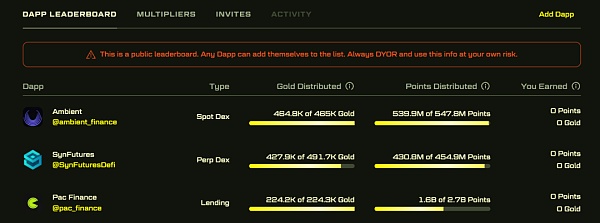
事件概述
Blast主网上线不到一个月,在2024年3月21日就发生了针对SSS Token(Super Sushi Samurai)的攻击,Token合约中存在一个转账逻辑错误,导致攻击者可以凭空增加指定账户的SSS Token余额,最终项目损失了超过1310 ETH(约460万美元)。
而在SSS Token攻击事件过去不到一周的时间,Blast上又发生了一起更大的攻击事件,Munchables项目被攻击者一把卷走了17413.96 ETH,共约6250万美元。
在这笔攻击交易发生的半小时后,项目方合约里的73.49 WETH也被黑客盗取到的另外一个地址。
此时项目方的合约地址上,还存着7276个WETH、7758267个USDB、4个ETH,随时会落入黑客手里,而黑客拥有拿走整个项目的所有资金的权限,共计约9700万美元暴露于风险之中。
在事件后发生的第一时间,X(Twitter)的知名链上侦探zachXBT指出本次攻击的根本原因是由于雇佣了某国黑客所致。
让我们深入看看,“某国黑客”是如何完成一次接近一亿美元的攻击。
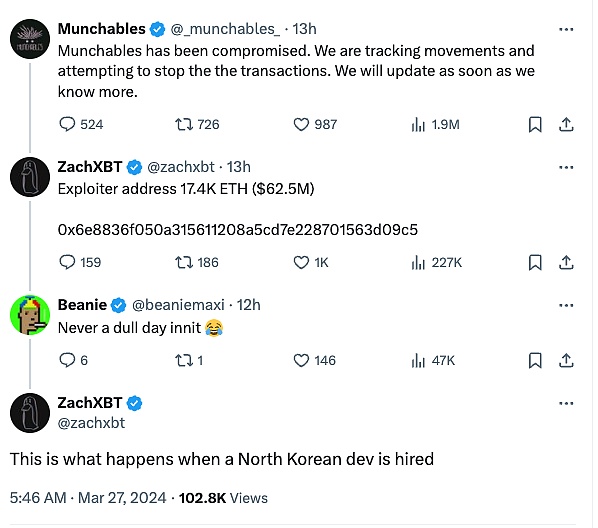
现场还原
受害者发声
[UTC+0]2024年3月26日21点37分(攻击发生5分钟后),Munchables官方在X(Twitter)发文表示遭到攻击。

按链上侦探ZachXBT的调查,是因为他们有一位开发者是“某国黑客”,aavegotchi的创始人coderdannn也在X(Twitter)上表示:“Aavegotchi的开发团队Pixelcraft Studios在2022时曾短期雇用过Munchables攻击者来进行一些游戏开发工作,他技术很糙,感觉确实像一名某国黑客,我们在一个月内解雇了他。他还试图让我们雇用他的一位朋友,那个人很可能也是一名黑客。”
由于这次攻击让社区的用户损失巨大,我们立即启动了链上调查,让我们深入看看这个“某国黑客”的攻击细节。
第一现场
[UTC+0]2024年3月26日21点32分,涉及17413.96 ETH的攻击发生了。
通过Blastscan我们可以看到这笔攻击交易:https://blastscan.io/tx/0x9a7e4d16ed15b0367b8ad677eaf1db6a2a54663610696d69e1b4aa1a08f55c95
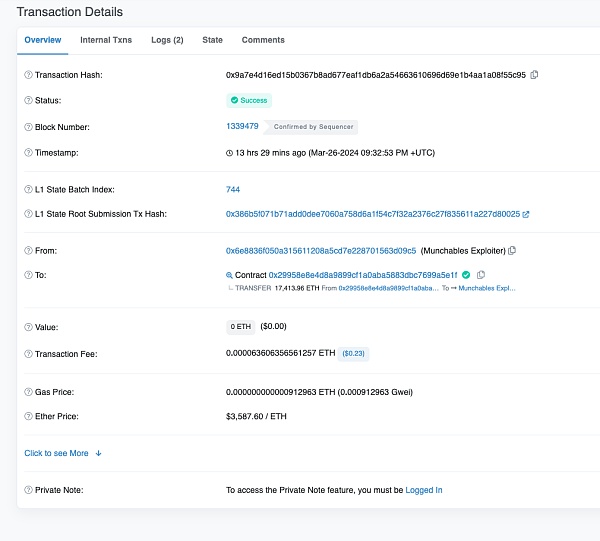
受损合约(0x29..1F)是一个代理合约,存放了用户质押的资金,我们可以看到,攻击者调用了质押合约的unlock函数,并通过了所有的权限校验,转走了合约中所有的ETH到攻击者地址1(0x6E..c5)。

看上去攻击者调用了一个类似withdraw行为的unlock函数,取走了受损合约(0x29..1F)上大部分ETH。
是项目方的金库忘了上锁吗?
受损合约(0x29..1F)中的unlock存在两个相关校验,我们一个一个来看。
首先,我们发现在校验权限的流程中,调用了合约(0x16..A0)的isRegistered方法来查看当前的msg.sender,也即是黑客地址1(0x6E..c5)是否已经被注册过:

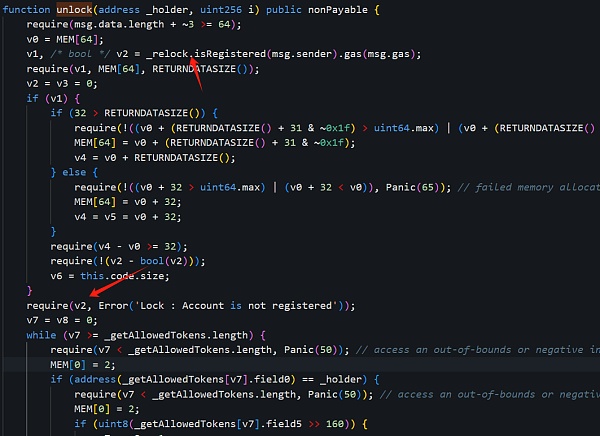
答案是:通过了验证。
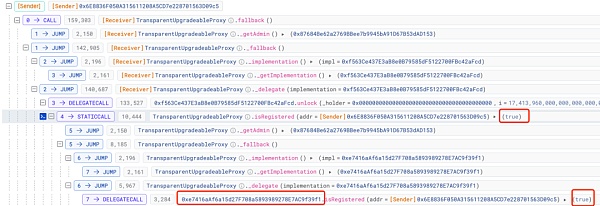
这里涉及到了合约(0x16..A0)以及其对应的最新的逻辑合约(0xe7..f1)
[UTC+0]2024年3月24日08点39分(攻击发生的2天前),合约(0x16..A0)对应的逻辑合约被升级了。

逻辑合约升级交易:
https://blastscan.io/tx/0x9c431e09a80d2942319853ccfdaae24c5de23cedfcef0022815fdae42a7e2ab6
逻辑合约被更新至0xe7..f1。
最初的逻辑合约地址在这里能看到,为0x9e..CD。
https://blastscan.io/tx/0x7ad050d84c89833aa1398fb8e5d179ddfae6d48e8ce964f6d5b71484cc06d003

此时,我们怀疑黑客是更新代理合约的逻辑实现合约,将为0x9e..CD变成恶意的0xe7..f1,完成了验证权限的绕过。
真的是这样吗?
在Web3.0从来不需要猜测和听信别人,你只需要掌握技术就能自己得到答案。
我们通过对比两份合约(未开源合约),最初的0x9e..CD合约与更新后0xe7..f1存在一些明显的区别:
0xe7..f1的initialize函数部分实现如下:
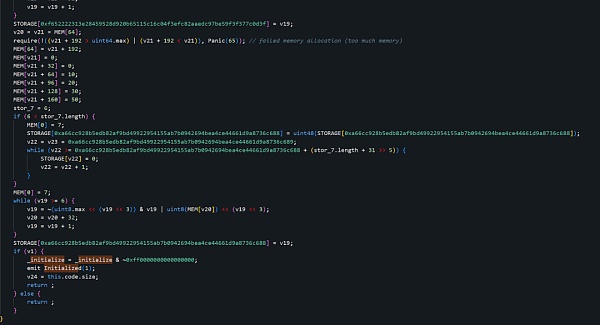
0x9e..CD的initialize函数部分实现如下:

可以看到,攻击者在最初的逻辑合约(0x9e..CD)中,将攻击者地址(0x6e..c5)设置为register,同时还有其他两个攻击者地址0xc5..0d、0xbf..87也被register了,并且它们的field0被设置为初始化时的区块时间,field0后面会解释用处。
实际上,和我们猜测的恰好相反,真正的藏有后门的逻辑合约,反而是最初就存在,而后面更新的反而是正常的!
等等,这个更新出现在[UTC+0]2024年3月24日08点39分(攻击发生的2天前),也就是在这个事件之前,逻辑合约已经变成没有后门的合约了,为什么后面攻击者还可以完成攻击?
这是因为delegatecall的原因,所以实际的状态存储更新是在合约(0x16..A0)中,这也就导致了即使之后逻辑合约被更新至没有后门的逻辑合约0xe7..f1,合约(0x16..A0)中被更改的slot依然不会恢复。
我们来验证一下:

可以看到,合约(0x16.....A0)中对应的slot是有数值的。
这使得攻击者能够通过isRegistered方法的校验:

攻击者之后再将后门合约更换为正常合约掩人耳目,其实此时后门早已种下。
另外,在unlock的流程中,还涉及到第二个校验:
对于lock时间的检查,这一部分是保证锁定的资产不会在未到期就被转走。

攻击者需要保证当unlock被调用时的区块时间大于要求的锁定过期时间(field3)。
这一部分校验就涉及到受损合约(0x29..1F)以及对应的逻辑合约0xf5..cd。
在[UTC+0]2024年3月21日11点54分(攻击发生的5天前)的交易中,
https://blastscan.io/tx/0x3d08f2fcfe51cf5758f4e9ba057c51543b0ff386ba53e0b4f267850871b88170

我们可以看到受损合约(0x29..1F)合约最初的逻辑合约是0x91..11,而在仅仅四分钟后,就在
https://blastscan.io/tx/0xea1d9c0d8de4280b538b6fe6dbc3636602075184651dfeb837cb03f8a19ffc4f

被升级为了0xf5..cd。
我们同样来对比两份合约,可以发现攻击者和之前一样,也在initialize函数做了手脚,
0xf5..cd的initialize函数部分实现:
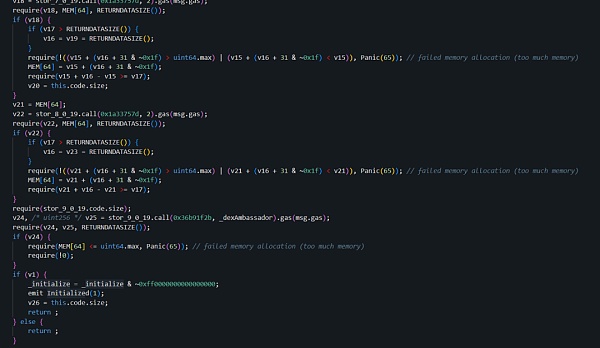
0x91..11的initialize函数部分实现:
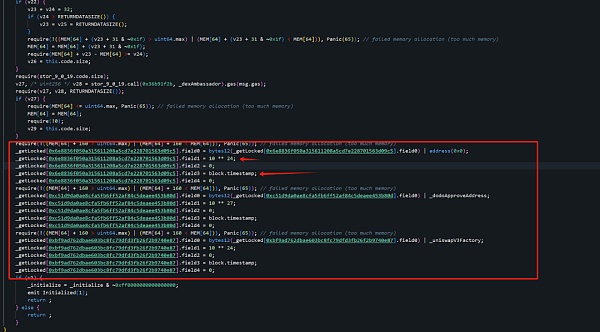
可以看到,很明显的,又是运用了同样的手法,将自己持有的ETH数量&解锁时间都进行了篡改,之后再替换回正常合约掩人耳目,当项目方和安全研究人员在Debug的时候,看到的逻辑合约全是正常的,而且由于合约均为未开源合约,更难以看清问题的核心。
至此,我们了解了这笔涉及17413 ETH的交易,攻击者是如何做到的,但是这个事件背后的信息,只有这么多吗?
我们上面的分析中,其实看到黑客在合约内部内置了3个地址:
0x6e..c5(攻击者地址1)
0xc5..0d(攻击者地址2)
0xbf..87(攻击者地址3)
而我们上面发现的攻击交易中只看到0x6e..c5,其他两个地址都做了什么?而且里面的address(0)、_dodoApproveAddress、_uniswapV3Factorty到底还隐藏着什么秘密?
第二现场
我们先来看看攻击者地址3(0xbf..87),通过同样的手法盗取了73.49 WETH:
https://blastscan.io/tx/0xfc7bfbc38662b659bf6af032bf20ef224de0ef20a4fd8418db87f78f9370f233
并且攻击gas的来源地址(0x97..de),同时给0xc5..0d(攻击者地址2)和0xbf..87(攻击者地址3)都提供了手续费。
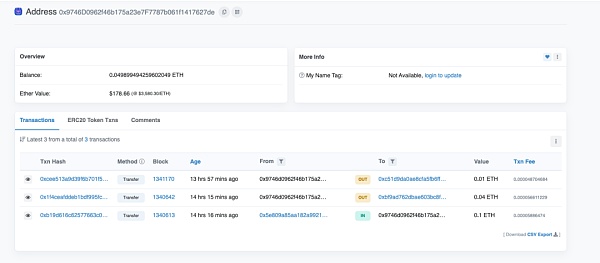
而攻击gas来源地址(0x97..de)的0.1 ETH的资金源头来自owlto.finance(跨链桥)。
0xc5..0d(攻击者地址2)收到手续费后,并未进行任何攻击,但它其实肩负了一个隐藏的计划,我们继续看下去。
实际上,根据官方的事后救援交易,原来受损合约(0x29..1F)地址上并不止73.49枚weth,直到攻击结束,也仍有7276.5 WETH & 7758267 USDB。
救援交易:
https://blastscan.io/tx/0x1969f10af9d0d8f80ee3e3c88d358a6f668a7bf4da6e598e5be7a3407dc6d5bb
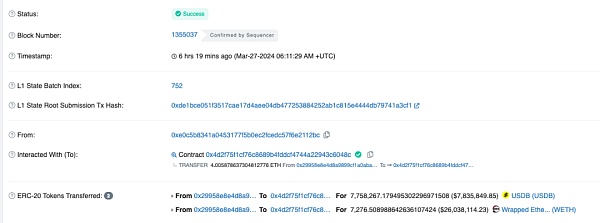
原本攻击者是打算盗取这些资产的,可以看到0xc5..0d(攻击者地址2)这个地址原本是用来偷取USDB的。

这里的_dodoApproveAddress为0x0000000000000000000000004300000000000000000000000000000000000003

为usdb的address

0xbf..87(攻击者地址3)这个地址是用来偷取weth的:

这里的_uniswapV3Factory为0x0000000000000000000000004300000000000000000000000000000000000004

为weth的address

而0x6e..c5(攻击者地址1)负责盗取的是address(0),即是原生资产ETH。
攻击者通过设置field0,即可通过如下逻辑对对应资产进行盗取:
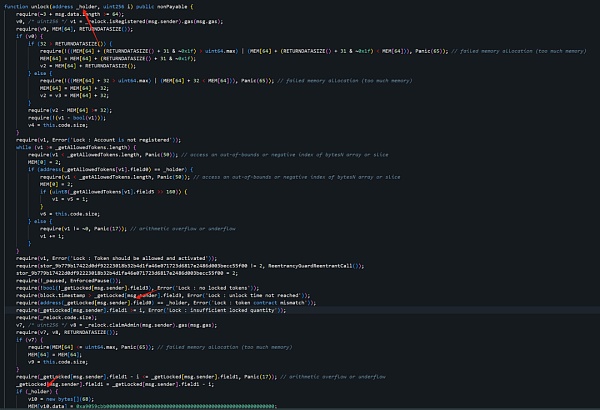
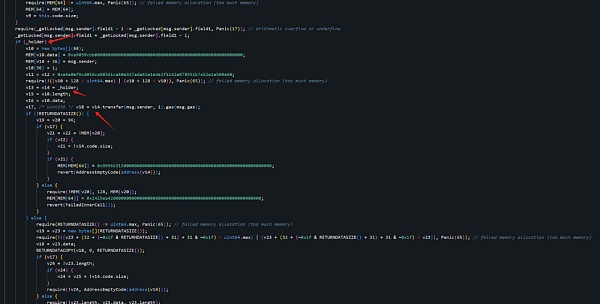
问题
为什么攻击者没有盗走所有资产?
理论上他可以盗取所有的资产,即剩下的WETH和USDB。
0xbf..87(攻击者地址3)只盗取了73.49 WETH,0xbf..87(攻击者地址3)其实完全可以把所有的7350 WETH拿走,也可以借助0xc5..0d(攻击者地址2)把7758267 USDB全部拿走,为什么只拿了一点点WETH就停下来了,我们不得而知,可能需要知名链上侦探深入内部的调查了。
https://blastscan.io/tx/0xfc7bfbc38662b659bf6af032bf20ef224de0ef20a4fd8418db87f78f9370f233

为什么攻击者没有把17413ETH转到Ethereum主网?
众所周知,Blast主网是有可能通过中心化的方式拦截这些ETH,让它永久停留在这里,从而不会造成实质上的用户损失,但是一旦这些ETH进入Ethereum主网,就没有办法拦截了。
我们评估了当前Blast的跨链桥,官方跨链桥没有限制数量,但是需要14天的退出时间,因此足以让Blast官方来准备拦截的计划。
而第三方的跨链桥是可以接近实时到账的,就像攻击者的手续费来源一样,很快完成跨链,为什么攻击者没有第一时间进行跨链?
实际上攻击者在第一时间(攻击的2分钟内)进行了跨链:
https://blastscan.io/tx/0x10cf2f2b884549979a3a1dd912287256229458ef40d56df61738d6ea7d9d198f

而且资金花了20秒就在Ethereum主网到账了,理论上攻击者可以持续不断进行跨链,可以在跨链桥人工干预之前,将大量ETH跨链转走。
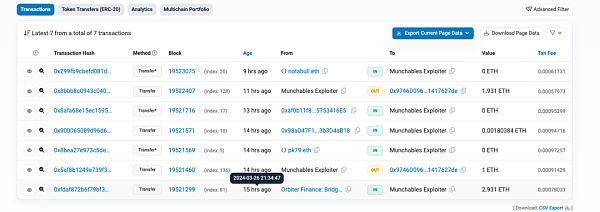
至于为什么只能每次3 ETH,原因是跨链桥的流动性限制,从Blast上跨到ETH上:
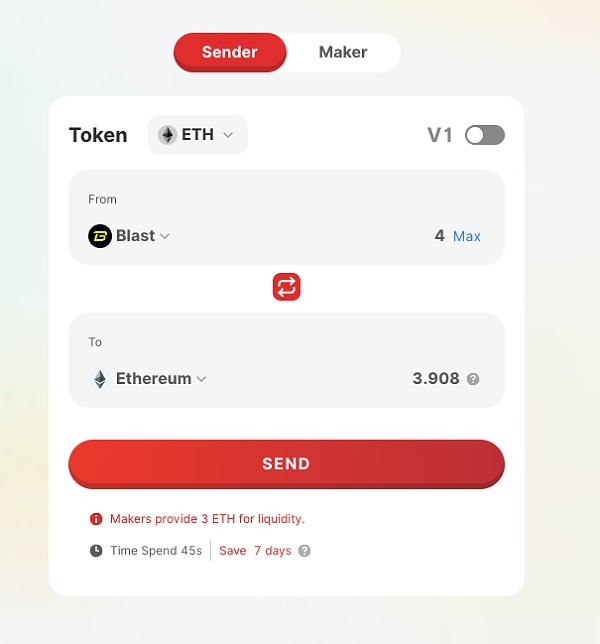
另一家支持Blast的跨链桥则支持的更少:
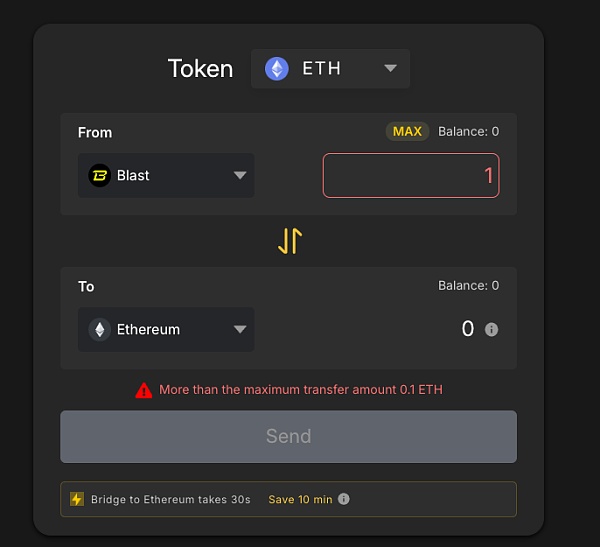
而在这一笔跨链交易后,攻击者没有继续其他的跨链操作,原因我们不得而知,看上去“某国黑客”似乎是没有为资金退出Blast进行充足的准备。
攻击后的事件发展
根据社区用户Nearisbuilding的反馈,他找到了攻击者的更多身份信息,并且想办法促使攻击者归还资金。
https://twitter.com/Nearisbuilding/status/1772812190673756548
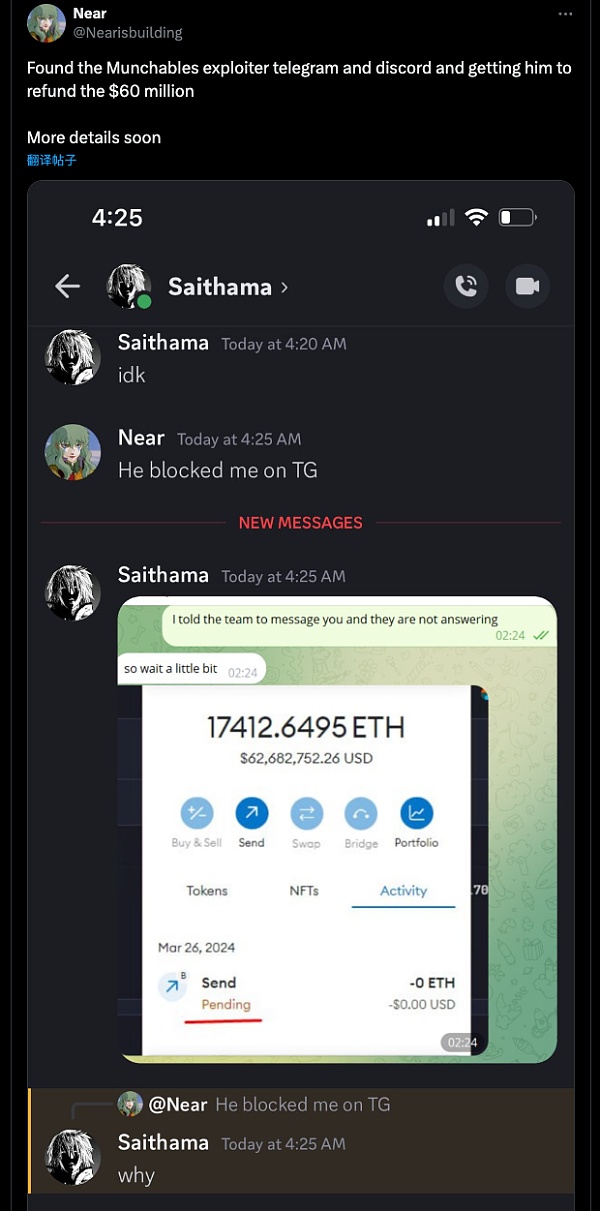
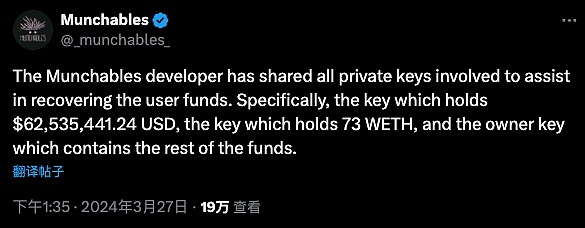
最终,在加密社区的关注和努力下,“某国黑客”也许因为害怕暴露身份,向项目方提供了以上3个攻击者地址的私钥,并归还了所有资金,项目方也进行了救援交易,把受损合约的资金全部转到多签合约进行保管。
The background is that the network launched by Tie Shun, the founder of, started the main network on January. At present, there are about projects that are attacked on the main network and pledged. The winning high-quality projects are held in competitions. In order to encourage users to participate in ecological projects, the official will select high-quality projects to recommend and encourage users to pledge the second time to the network, so they can get faster points increase and gold points. Therefore, a considerable number of users pledge the pledge on the main network to the new creation. The maturity and security of these projects need to be examined whether these contracts have enough security considerations to keep users' tens of millions or even hundreds of millions of dollars. Overview of the incident, there was an attack on the main online line less than a month ago. There was a transfer logic error in the contract, which led the attacker to increase the balance of the designated account out of thin air. Eventually, the project lost more than about 10 thousand dollars, and a bigger attack occurred less than a week after the attack. The attacker swept away a total of about 10,000 dollars. Half an hour after the attack, another address in the project contract was stolen by hackers. At this time, there are still hackers at the contract address of the project party, and the hackers have the right to take all the funds of the whole project. The total amount of about 10,000 dollars is exposed to risks. The well-known detectives on the chain pointed out that the root cause of this attack was due to the hiring of hackers from a certain country. Let us. In-depth look at how a hacker in a country completed an attack of nearly 100 million dollars to restore the voice of the victim on the spot. Minutes after the attack, the official issued a document saying that he was attacked. According to the investigation of the chain detective, one of their developers was the founder of a hacker in a country, and the development team mentioned in the above also hired an attacker for a short time to develop some games. His skills were very rough and he really felt like a hacker in a country. We fired him within one month and he tried to let us hire him. With one of his friends, that person is probably also a hacker. Because of this attack, the users in the community have suffered huge losses. We immediately launched an on-line investigation. Let's take a closer look at the details of the attack of hackers in this country. The attack involved in the first scene occurred at every minute of the year, month and day. We can see that the damaged contract was an agency contract, and the funds pledged by the users were deposited. We can see that the attacker called the functions of the pledge contract and passed all the authority checks to transfer the contract. It seems that the attacker called a function with similar behavior and took away most of the damaged contracts. Did the project party forget to lock the vault? There are two related checks in the damaged contracts. Let's look at them one by one. First of all, we found that the contract method was called in the process of checking the permissions to see if the current hacker address has been registered. The answer is that it has passed the verification. Here, the contract and its corresponding latest logical contract are involved. The logical contract corresponding to the contract was upgraded the day before the attack. The logical contract was upgraded and the transaction logical contract was updated to the original logical contract address, which can be seen here. At this time, we suspect that the hacker is updating the logical implementation of the agency contract, and the contract will bypass the verification authority to become malicious. Is this really the case? You only need to master the technology to get the answer yourself. We compare the original contract with the updated one. In some obviously different function parts, the following function parts are realized as follows. It can be seen that the attacker set the attacker's address to at the same time in the initial logical contract, and two other attacker's addresses were also taken, and their use will be explained later when they were set to the block time at initialization. In fact, contrary to what we guessed, the real logical contract with the back door actually existed at first, but the later update was normal, and so on. Before the attack, that is, before this event, the logical contract has become a contract without a back door. Why can the attacker finish the attack later? This is because the actual state storage is updated in the contract, which leads to the fact that even if the logical contract is updated to a logical contract without a back door, it will not be restored. Let's verify that the corresponding value in the contract is numerical, which enables the attacker to verify the attacker through the method. After that, the back door contract will be replaced by a normal contract to hide people's eyes and ears. In fact, at this time, the back door has already been planted. In addition, the second check is involved in the existing process. This part is to ensure that the locked assets will not be transferred before the expiration. Attackers need to ensure that the block time when called is longer than the required lock expiration time. This part of the check involves the damaged contract and the corresponding logical contract. We can see the damaged contract in the transaction days before the attack occurred. The original logical contract of the contract was upgraded only four minutes later. In order to compare the two contracts, we can find that the attacker also tampered with the function part of the function as before. It can be seen that it is obvious that the same method was used to tamper with the number of unlocking times held by himself, and then it was replaced by the normal contract. When the project party and security researchers were there, the logical contracts were all normal and made by. Since the contracts are all open source contracts, it is even more difficult to see the core of the problem. So far, we know how the attacker did this transaction, but is there only so much information behind this incident? In our analysis above, we actually saw that the hacker built an address inside the contract, and in the attack transaction we found above, we only saw what the other two addresses did and what secrets were hidden inside. Let's look at the second scene first. Look, the attacker's address was stolen in the same way, and the source address of the attack provided both the attacker's address and the attacker's address with a handling fee, while the source of the funds for attacking the source address came from the cross-chain bridge. After receiving the handling fee, the attacker's address did not carry out any attack, but it actually shouldered a hidden plan. We continued to look at it. In fact, according to the official post-rescue transaction, there were more than one damaged contract address, and there were still rescue transactions until the end of the attack. Originally, the attacker intended to steal these assets. You can see the attacker's address 比特币今日价格行情网_okx交易所app_永续合约_比特币怎么买卖交易_虚拟币交易所平台
注册有任何问题请添加 微信:MVIP619 拉你进入群

打开微信扫一扫
添加客服
进入交流群
1.本站遵循行业规范,任何转载的稿件都会明确标注作者和来源;2.本站的原创文章,请转载时务必注明文章作者和来源,不尊重原创的行为我们将追究责任;3.作者投稿可能会经我们编辑修改或补充。


















